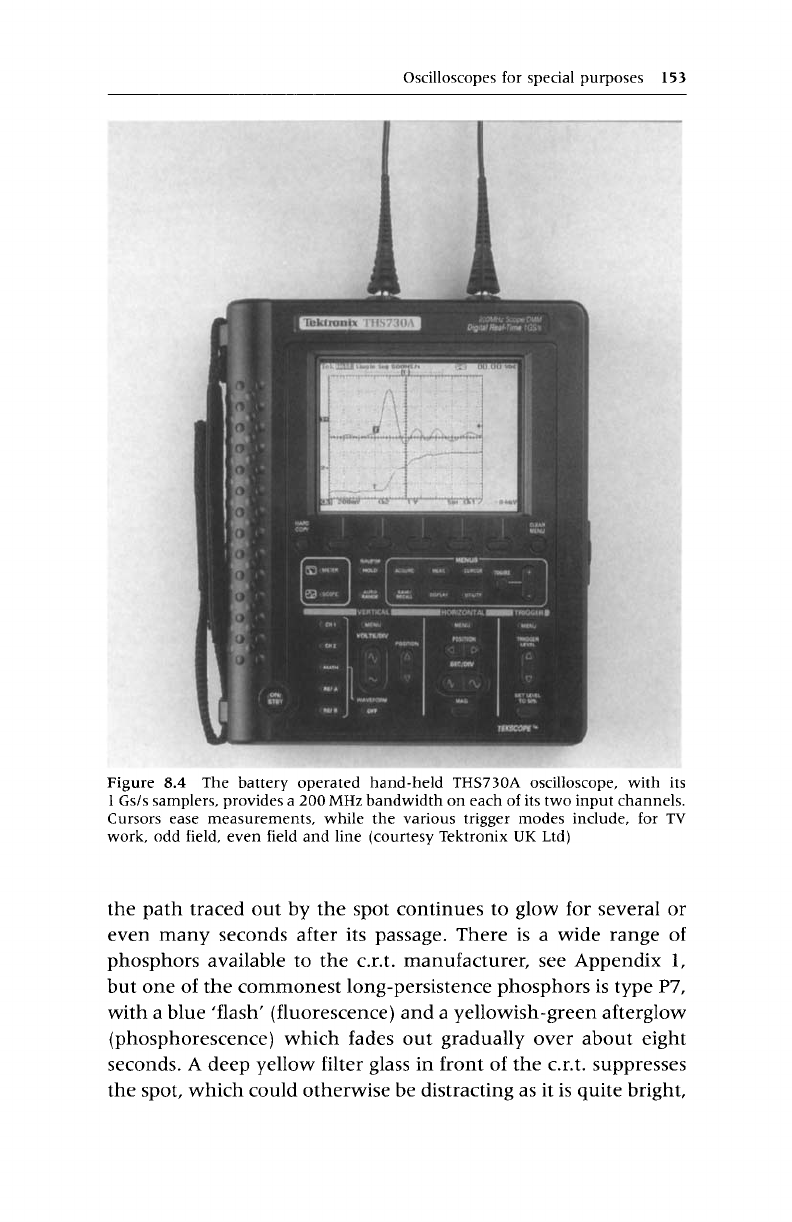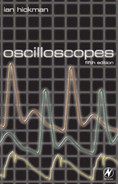
8
Oscilloscopes for special
purposes
It would be very difficult, indeed quite impossible, to design an
oscilloscope suitable for all the very wide range of uses to which
this most versatile of electronic instruments is put. Consequently
there is and always will be a wide variety of oscilloscopes, each
aimed primarily at its own particular field of application.
Of course a mainframe plus plug-in approach permits one
oscilloscope (plus a cupboard full of plug-ins) to cover a wide
variety of uses, but this format is confined to medium and large
oscilloscopes. The mainframe will be either an analogue-only
scope, or offer storage facilities, nowadays invariably digital
storage as manufacturers no longer offer oscilloscopes using the
type of storage tube described in Chapter 11. A non-storage scope
may be cheaper than a DSO of comparable
single shot
bandwidth,
though the price differential is decreasing steadily. But first let us
consider the smaller, simpler, specialized instruments.
Small portable scopes
Being such versatile instruments, oscilloscopes often get used in
inaccessible places, down a hole in the ground, for example, or at
the top of a pole. Here, a small, light instrument, powered from
internal batteries, has obvious advantages. Figures 8.1 to 8.4
show a selection of such instruments, some powered from
internal primary ('dry') batteries and some from internal second-
ary (rechargeable) batteries. Often the latter variety incorporates
a mains-powered battery charger, and depending on the make
and model it may also be possible when mains is available to use
the oscilloscope whilst simultaneously recharging the battery for
later portable use.
Figure 8.5 shows another eminently portable oscilloscope, the
Fluke 'ScopeMeter'| model 123 with a 20 MHz bandwidth. The
instrument also doubles as a dual input recorder, and as two 5000
counts true-rms digital multimeters. An optically isolated RS-232

150 Oscilloscopes
Figure 8.1 Tile Hitachi V-209 20MHz dual trace portable oscilloscope operates
fronl its internal battery pack, external 12 V d.c. or 90-260 V a.c. mains supply
(courtesy Thurlby-Thandar Lid)
interface is provided, and the instrument is safety certified to
600 V CAT III level. A line powered adapter/battery charger is
included, but - while weighing in at just 1.2 kg- the model 123
provides 5 hours' portable mains-free operation from its internal
NiCad batteries. Other models in the range include the Scope-
Meter@ 199, with two input channels each having a maximum
digitizing rate of 2.5 Gs/s. This provides a 200MHz bandwidth
without resort to sine interpolation. For less demanding applica-
tions, the range also includes 100 MHz and 60 MHz models.

Oscilloscopes for special purposes 151
Figure 8.2 The ADC200 is a PC-based 'virtual oscilloscope', connecting to the
host personal computer via a parallel port. A different port (LPT2, say) from the
printer's LPT1 is a good idea. Advanced trigger modes, such as 'save to disk on
trigger, with time and date stamp', help track down intermittent faults. Three
models, with maximum sampling rates of 20, 50 and 100Ms/s, are available: all
provide 8 bit resolution. (Reproduced by courtesy of pico Technology Ltd)
Educational scopes
There is one category of oscilloscope, however, where high
performance is not so important a consideration. Much more
important in a scope for the educational market are simplicity of
operation, low cost and, above all, safety. Few oscilloscope
manufacturers specifically address this market, being content with
the hope (often forlorn) that the lowest price model in their range
will pick up some educational sales. One of the few manufacturers
with a product truly designed from the ground up for this
particular market is Metrix. Figure 2.3 shows their model OX71
'Didascope', so named from its didactic connotations. From the
point of view of the parameters most important in a high-
performance scope, its specification is very modest- just a single
channel with 5 MHz bandwidth at a highest sensitivity of 50 mV/
division. However, in view of its intended sphere of operation, it is
double insulated (making it suitable for floating measurements)
and meets safety specification EN61010 (IEC 1010-1 ), class II. For
ease of operation, automatic triggering is available and the
instrument even offers XY operation and Z modulation.

152 Oscilloscopes
Long-persistence scopes
Traditionally, an important category of special-purpose oscillo-
scopes was that used for displaying low-frequency repetitive
waveforms, or fast single shot events. With the medium/short
persistence phosphors such as P31 used in the majority of
oscilloscopes, flicker of the trace will be noticed when its
repetition rate is much lower than 50 times per second. The lower
the repetition, the worse the flicker, and at about 15 traces per
second the eye ceases to see a trace at all, seeing only a moving
spot of light bobbing up and down.
One solution to this problem is to use an oscilloscope fitted
with a c.r.t, having a long-persistence phosphor. With this type,
Figure 8.3 The notebook type VC-5430 portable oscilloscope runs from internal
batteries, dedicated a.c. power adaptor or external battery pack. Its two 30Ms/s
input channels each provide a 50 MHz bandwidth, with timebase speeds down to
5 ns/div. The instrument's most unusual feature is a backlit colour-TFT liquid
crystal display, adding clarity to multi-trace displays (courtesy Hitachi Denshi
(UK) Ltd)

Oscilloscopes for special purposes 153
Figure 8.4 The battery operated hand-held THS730A oscilloscope, with its
1 Gs/s samplers, provides a 200 MHz bandwidth on each of its two input channels.
Cursors ease measurements, while the various trigger modes include, for TV
work, odd field, even field and line (courtesy Tektronix UK Ltd)
the path traced out by the spot continues to glow for several or
even many seconds after its passage. There is a wide range of
phosphors available to the c.r.t, manufacturer, see Appendix 1,
but one of the commonest long-persistence phosphors is type P7,
with a blue 'flash' (fluorescence) and a yellowish-green afterglow
(phosphorescence) which fades out gradually over about eight
seconds. A deep yellow filter glass in front of the c.r.t, suppresses
the spot, which could otherwise be distracting as it is quite bright,
..................Content has been hidden....................
You can't read the all page of ebook, please click here login for view all page.
